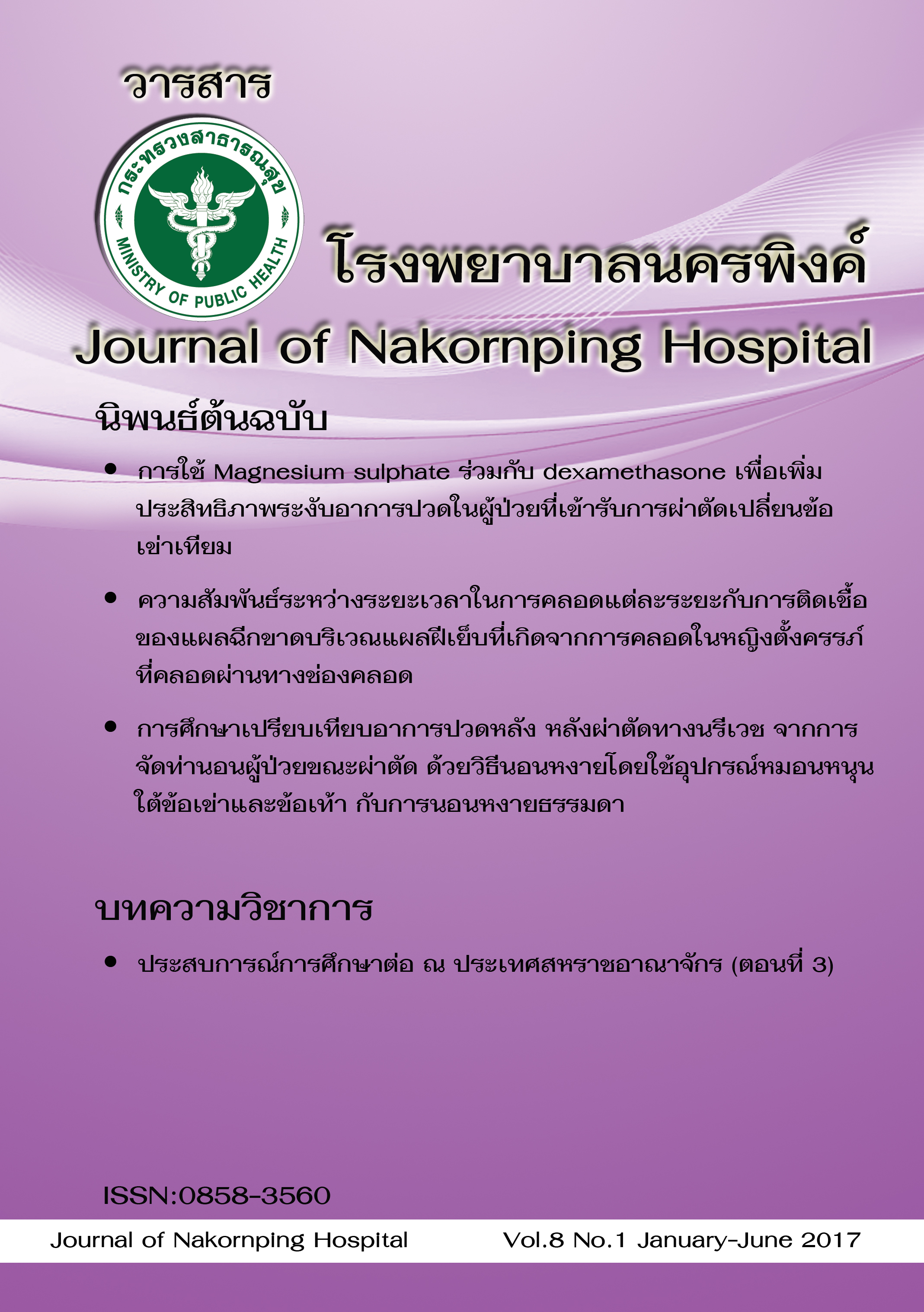Relations between the timing of birth and obstetric perineal wound infection
Keywords:
Episiotomy, Episiotomy wound infection, Perineal wound, PerinealAbstract
background Patients who infected obstetric perineal woundaveincreased, Leading to impact on them and their families.There havemany risk factors of infection including long duration of delivery. Studyingrelation between the timing of labor in 1st stage,2nd stage,3rdstage ,totaltime of the laborand obstetric perineal wound infection is necessary. Method 170 patientswere infected 34 cases andwerenot infected 136cases.Studying in patients who were delivery a child atnakornpinghospitalon October 5, 2016 to September 30, 2017.The study wasretrospectivecasecontrol.Collecting period of labor, generalinformationandthe other factors that may affect the infection.Analyzedthe proportion and all of risk factorsbydescriptive statistic, Logisticregression.Therelation between the timing of labor in 1st stage,2ndstage,3rdstage ,total time of the labor and obstetric perineal woundinfection was analyzed usinglogistic regression
Results In this study,The findings showed increasingtimesin1st stage,2ndstage,3rdstageof laborand total time of laborwas not related toinfectionthat analyzed by univariable logistic regression (p-value=0.857,p-value=0.124, p-value=0.260, p-value=0.593, respectively). The timingof2ndstageof laborand factors which may affect the infectionwere notrelated to infectionwhen analyzed bymultivariable logistic regression (pvalue=0.304)
Conclusion In this study showedthatno relationbetweentimingoflaborandinfectionwhencontrolledall factors that may affect theinfection
References
2. Horan, T. C., Gaynes, R. P., Martone, W. J., Jarvis, W. R., &Emori, T. G. CDC Definitions of Nosocomial Surgical Site Infections, 1992: A Modification of CDC Definitions of Surgical Wound Infections. Infection Control & Hospital
Epidemiology 1992;13:606-8.
3. Jing-yan, Y. A. N. G. Logistic Regression Analysis on Risk Factors of Episiotomy Infection. Chinese Journal of Nosocomiology 2009;2:164-5.
4. Johnson A, Thaker R, Sultan AH. Obstetric perineal wound infection. British J. of Nursing 2012;21:s28-s53.
5. Kamel, A., Khaled, M. Episiotomy and obstetric perineal wound dehiscence: beyond soreness. Journal of Obstetrics and Gynaecology 2014;34:215-7.
6. Li, H., Zhong, Q., Jin, S., Gao, X., Cheng, J., Wang, C., & Gong, R. Factor analysis of side perineal incision infection and control measures of perinatal quality. Chinese Journal of Nosocomiology 2010;20:2606-7.
7. O’Kelly, S. M., Moore, Z. E. H. Antenatal maternal education for improving postnatal perineal healing for women who have birthed in a hospital setting.Cochrane Database of Systematic Reviews 2017;12:CD012258.
8. Ridley, N.Perineal wound infections: an audit. The Practicing Midwife 2015;18:1-4.
9. Rusavy, Z., Karbanova, J., &Kalis, V. Timing of episiotomy and outcome of a non‐instrumental vaginal delivery. Actaobstetricia et gynecologicaScandinavica 2016;95:190-196.
10. Wang, J., Huang, L. H., You, L. J., & WU, L. X. Risk factors for episiotomy incision infections and prevention and control measures. Chinese J Nosocomiol2013;23:371-73.
11. Zhang, H, Han, S.Risk factors and preventive measures for postoperative infection in episiotomy of puerperal.Biomedical Research 2017;28:8857-61.
Downloads
Published
How to Cite
Issue
Section
License
The articles that had been published in the journal is copyright of Journal of Nakornping hospital, Chiang Mai.
Contents and comments in the articles in Journal of Nakornping hospital are at owner’s responsibilities that editor team may not totally agree with.



